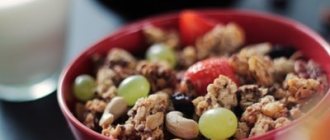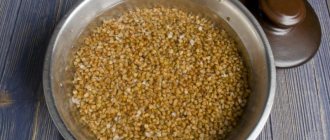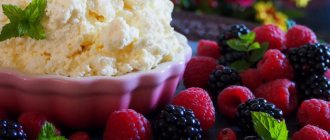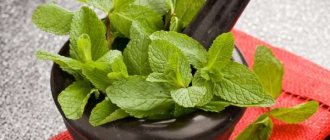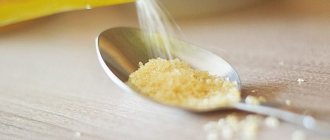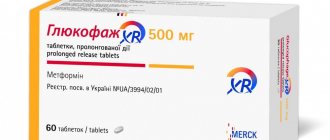List of the lowest calorie cereals for weight loss
Everyone eats different cereal dishes.
For some it’s just for breakfast, for others it’s an excellent side dish, but for those who are on mono diets that consist only of cereals, there are countless of them. But which cereals are healthy and really help you lose weight, and which ones only slow down your metabolism? Are there really weight loss cereals that burn fat? First things first. In fact, cereals are the richest sources of carbohydrates, and those who are losing weight believe that it is carbohydrates that make them fat. But that's not true. There are two types of carbohydrates:
• Fast carbohydrates. These carbohydrates are quickly digested and increase your sugar levels. These products include: fruits, bakery sweets, cakes, pastries, chocolate;
• Slow carbohydrates. The body takes quite a long time to digest foods that contain slow carbohydrates, and, therefore, after them there is no feeling of hunger for a long time. Just cereals are one of them.
Of course, in addition to carbohydrates, cereals are rich in other beneficial properties: proteins, fiber and various minerals. All this helps to normalize the functioning of the body. Porridge is useful for losing weight and maintaining normal stomach function. But not all of them help burn fat, and even interfere if prepared incorrectly, especially if the porridge is flavored with butter and cooked with full-fat milk.
What cereals can you eat while losing weight?
• Oatmeal ranks first on the list of healthy cereals for weight loss.
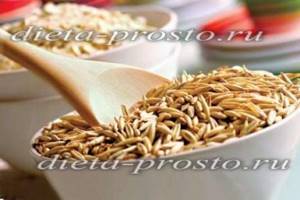
One of the finest porridges, which has the lowest calorie content (366 kcal). High in protein, it also contains fats, carbohydrates, phosphorus, zinc and a huge amount of fiber (which is very important to consume for the normal functioning of the body).
Oatmeal is known for its effect on the intestines as a scrub. It perfectly cleanses the body of unnecessary toxins and gives a quick feeling of fullness that lasts a long time. Oatmeal improves the functioning of the immune system. But it should be remembered that instant oatmeal (which only needs to be poured with boiling water) is not suitable for a diet, since it does not contain even half of the beneficial substances of oatmeal, i.e. the usefulness of porridge in this case is reduced almost threefold.
It is better to eat oatmeal in the morning for breakfast. It kind of envelops the stomach and clears away excess, so both lunch and dinner will settle in the stomach much faster. But you should remember that you shouldn’t overeat oatmeal either, this can lead to you gaining weight, although oatmeal makes a normal body feel full very quickly.
• Next on the list of dietary cereals for weight loss is queen buckwheat.
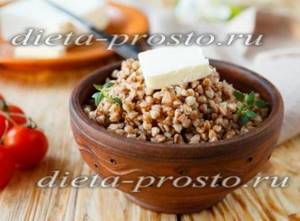
It is rightfully considered healthier than many other cereals. It is one of the lowest in calories (331) and contains a large amount of protein. Buckwheat contains a full range of substances and microminerals necessary for the body.
Eating buckwheat for weight loss is a great idea. Buckwheat porridge does an excellent job of satisfying hunger, and therefore it is a good idea to use it as a side dish. Thanks to the buckwheat side dish, you will eat less other foods. That is why the buckwheat diet is the most popular diet, thanks to which you can quickly lose weight.
• Pearl barley rightfully occupies third place.
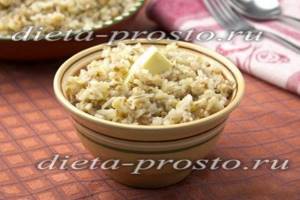
Yes, it is much more difficult to prepare than other cereals, since it must be thoroughly washed and soaked for several hours before cooking, preferably overnight, and cooked the next morning. But this does not detract from its amazing taste and magical effect on the body. Pearl barley has a low calorie content (320 calories) and contains (in addition to proteins, fats and carbohydrates) vitamins and essential microelements.
But pearl barley has an undeniable advantage over other cereals - it is the most powerful antioxidant and contains substances that improve the production of collagen, which, in turn, slows down the appearance of wrinkles.
• The fourth place is occupied by flaxseed porridge, which is not yet in great demand in Russia.
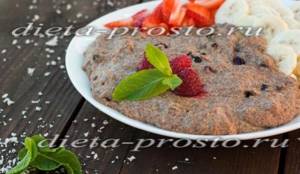
But in vain, because flax seeds are the lowest in calories (295 kilocalories), contain amino acids, B vitamins and a lot of other important microelements. It also perfectly improves digestion.
• Barley porridge is an excellent ally for weight loss because it is very low in calories.

And its advantage is that it takes more calories to digest it than it contains. Those. By eating only barley, you can really lose weight and burn calories. In addition, it is rich in minerals and vitamins.
Barley porridge is recommended not only for those who want to lose weight, but also for diabetics, because it reduces the amount of sugar in the blood. And like oatmeal, it perfectly cleanses the intestines and quickly copes with constipation. However, those who suffer from diarrhea should limit their consumption of barley porridge.
• For those who watch their figure, it is no longer news that wheat porridge helps to stay in good shape.
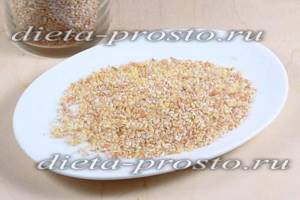
It is very low in calories, helps regulate the body's metabolism and removes cholesterol. If you have problems with hair and nails, millet cereal will be perfect; by the way, it contains a lot of calcium, which will strengthen your nails and stop hair loss. In addition, wheat porridge perfectly improves immunity.
• Millet cereal is no less useful.
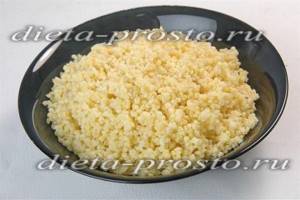
It is also very low in calories and helps remove excess fat. Its properties are very similar to wheat porridge. When choosing millet cereal, you should pay attention to its color; the brighter the color, the more nutrients it contains.
Now you have the answer to the questions “which porridge is the lowest in calories” and “which cereal is the healthiest,” so don’t worry about choosing, but alternate the healthiest cereals for weight loss.
Unfortunately, not all cereals are equally beneficial for weight loss. There is also a list of cereals that, on the contrary, slow down weight loss. But this does not mean that they need to be completely excluded from the diet; you even need to eat them in small quantities, but in small quantities. What cereals are these?
• The most favorite since childhood - semolina porridge, is not the most favorable product for weight loss.
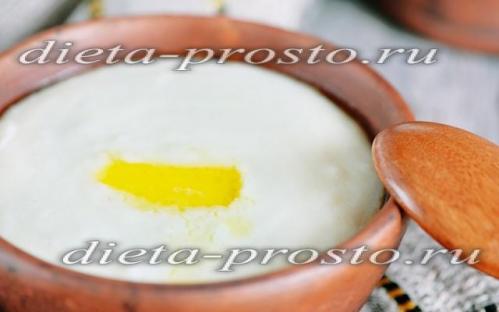
If you are looking for the answer to the question “what is the highest calorie porridge,” then here it is.
Semolina porridge is a bad ally for weight loss; it contains negligible substances and contains phytic acid, which interferes with the absorption of calcium. In other words, semolina porridge is a differently processed flour. But eating flour is not very good for your figure, so it’s clear that you can’t lose weight on semolina porridge. And when choosing cereal for a child’s breakfast in the store, the question “which” should exclude semolina.
• But now a very popular myth of all women's magazines will be destroyed. After all, in any glossy diet, there is a place for rice, and this is a terrible mistake, because rice porridge for weight loss not only will not help, but vice versa.
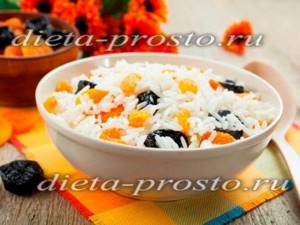
Despite the fact that rice is perfectly absorbed by the body, it has the same method of purification as semolina, and therefore contains almost no useful substances. But, of course, this does not apply to brown rice, which cannot always be found in a supermarket near your home.
Low-calorie porridges: which cereals to choose and how to cook
“Without porridge, lunch is not lunch,” “Porridge is our nurse,” “Without porridge, our labors are worthless”—the Russian people have long had a special attitude towards this dish.
Nowadays, for breakfast, it is increasingly being replaced with yoghurts, cottage cheeses, and even buns and sandwiches as a snack with coffee. They remember about it only when they start organizing proper nutrition or when it’s time to lose weight.
But here the question arises: which cereal should I prefer so that there are more health benefits and the extra pounds go away faster?
About low-calorie
Low-calorie cereals
Experts call low-calorie foods those whose calorie content per 100 g of weight does not exceed 100 kcal. From this point of view, there is no such thing as “dietary cereal”, because in dry form they all “weigh” 250 kcal and more. Therefore, we can highlight only those with the lowest indicator compared to others. Although the values of many of them are very close to each other.
Here and on many websites, the calorie content of dry cereal is given approximately. For example, for semolina, one online calorizer gives 335 kcal, another - 328, and a third - 322.
Just for fun, you can look at packaging from different manufacturers: Makfa semolina - 333 kcal, Eurozlak - 325, Uvelka - 350. And so with all products in this food category.
The fact is that this indicator depends on many factors: what grain was taken as a basis (soft or hard varieties, whole or pre-ground), what kind of processing the raw materials underwent, and the characteristics of the additives.
Low-calorie porridge
Compared to cereals, their calorie content is 2-3 times less. This happens for two reasons.
Firstly, the weight changes during cooking: from 1 cup of dry raw material, we get as many as 3 cups due to the addition of water (milk) and the swelling of natural fiber.
Secondly, during heat treatment, fats and other nutrients are evaporated, which essentially constitute the calorie content of any product.
As a result of all these processes, some porridges still turn out to be low-calorie, falling within the framework of 100 kcal per 100 g of ready-made dish. However, here the indicators will be quite conditional. Semolina from Eurozlak will make a lighter breakfast than if you use a product from.
About supplements
When selecting cereals for your breakfast, be sure to take into account the additives that will improve their taste. They can significantly change the indicator you need. Judge for yourself (approximate values):
- ½ tsp. cinnamon = 10 kcal;
- 1 tsp. honey = 25 kcal;
- 1 tsp. granulated sugar = 32 kcal;
- 1 tsp. raisins = 13.5 kcal;
- 1 tsp. olive oil = 89.8 kcal;
- 1 tbsp. l. chopped walnuts = 47 kcal;
- 1 tbsp. l. strawberries = 8 kcal, raspberries = 9 kcal, cranberries = 6 kcal;
- 1 tbsp. l. strawberry jam = 57 kcal, raspberry jam = 54 kcal, cherry jam = 51 kcal;
- 10 g butter = 74.8 kcal;
- 20 g of cheese = 52 kcal;
- 50 g bananas = 49 kcal, apples and cherries = 26 kcal, pears = 23 kcal;
- 50 g low-fat cottage cheese = 42 kcal;
- 100 ml of milk: 1% = 40 kcal, 2% = 45 kcal, 2.5% = 52 kcal, 3% = 58 kcal.
It’s not hard to guess that even the lowest-calorie porridge will cease to be so if you cook it in full-fat milk and add sugar, butter, nuts and fruits.
For weight loss, this risks going beyond the daily caloric intake and weight gain rather than weight loss. The most dietary one will be the one cooked in water and without any additives.
Yes, eating it will not be entirely pleasant, but the benefits for the body and figure will be beyond any doubt.
As for salt, it does not affect the calorie content of dishes in any way. However, it should not be abused. Its daily intake is significantly limited in the proper nutrition system, in treatment tables, and in weight loss diets. The reason is that it retains water in the tissues, disrupts the water-salt balance, and negatively affects kidney function.
Low-calorie cereals with calories indicated
In fact, the choice of cereals that we can prepare is not so large, since the range of cereals available to us in stores is limited. Therefore, we provide data for all the most popular ones.
The table is built taking into account the increasing calorie content of porridges cooked in water, since they are the lowest in calories. Indicators for dairy products are based on 1.5% milk fat content.
The figures are given without taking into account any additives. Only cereal and water or milk. All other ingredients that you use will add to the indicated calorie content.
Explanations:
- If the calorie content of varieties of the same cereal in dry form differs significantly (compare whole grain oats and rolled oats), then for porridges this difference is practically erased, because evaporation occurs approximately the same.
- Boiling of cereals in water and milk occurs differently. This explains why the lowest-calorie porridge made with water is barley porridge, and rice porridge made with milk.
Related article: Review of the best cereal diets
And
Based on the table above, it is easy to make ratings of the lowest-calorie cereals and cereals. But remember that they will be conditional. The values are as close as possible to each other and can change places in such a TOP.
For example, according to generally accepted standards, corn grits are higher than semolina (328 kcal versus 333). But it “weighs” 360 kcal, and semolina from Makfa weighs 333 kcal. So watch the packaging you buy.
porridge with water according to calorie content (hereinafter - from lowest to highest):
Almost all dishes included in this TOP 10, with the exception of the last position, can rightfully be called low-calorie, since they fit within the framework of less than 100 kcal per 100 g of a ready-made dish.
porridge with milk according to calorie content:
- Rice.
- Manna.
- Oatmeal.
- Barley.
- Corn.
- Millet.
- Spelled
- Wheat.
- Pearl barley.
- Buckwheat.
Here, in terms of low-calorie content, it is already much more difficult than with water options. Only the first 2 fall into the range of less than 100 kcal per 100 g of ready-made food. For the rest, this figure exceeds the established value.
dry cereals by calorie content:
- Oats (whole grain).
- Dried peas.
- Barley grits.
- Buckwheat is ordinary.
- Pearl barley.
- Corn grits.
- Semolina.
- Millet.
- Spelled
- Rice (brown).
As already mentioned, none of the cereals falls into the low-calorie category from a nutritional point of view. However, this is not so critical, since no one will eat them dry. And after boiling, this figure becomes several times less.
On the water
The lowest calorie porridge on water is barley (76 kcal).
What is it prepared from: from barley groats (cells), and this, in turn, is made from crushed barley.
Compound:
- calcium, potassium, phosphorus, iron, iodine, bromine, manganese, zinc, sulfur, molybdenum;
- niacin, ergocalciferol, tocopherol, thiamine, folic acid;
- complex carbohydrates, plenty of protein and fiber.
Benefit:
- cleanses the intestines;
- improves digestion;
- promotes weight loss;
- has a diuretic effect;
- indicated for diabetes and gastritis;
- supplies energy for the whole day;
- guarantees long-lasting and lasting saturation.
Proportions and cooking time:
- for crumbly porridge: for 1 cup of egg - 2 cups of water, cook for 15 minutes;
- for thick and viscous: 1 to 4, cook for 25 minutes;
- for semi-viscous (used in medical nutrition): 1 to 3, cook for half an hour.
It is better to pre-soak the cell in cold water for a couple of hours.
With milk
The lowest calorie porridge with milk is rice (97 kcal).
What is it made from: white or brown rice.
Compound:
- almost all B vitamins, especially a lot of thiamine, riboflavin and niacin, as well as tocopherol and phylloquinone;
- sodium, potassium;
- complex carbohydrates, protein, fiber.
Benefit:
- has an enveloping therapeutic effect on the stomach, indicated for any problems with the gastrointestinal tract;
- promotes weight loss;
- relieves swelling;
- improves blood composition;
- has a calming effect on the nervous system;
- normalizes blood pressure.
Proportions:
- as in kindergarten: for 1 glass of rice - 1 glass of water and 1 liter of milk;
- liquid: for ¾ cup of rice - 1 cup of water and 2 cups of milk;
- thick: for 1 cup of rice - 2 cups of milk.
Do not forget that you have a low-calorie dish, which means that milk should have no more than 1.5% fat content. Cooking time: 30 minutes. Pre-soaking the rice is not required. But it is necessary to rinse it in running cold water.
Groats
The lowest calorie cereal of all is whole grain oats (250 kcal).
Compound:
- retinol equivalent, riboflavin, thiamine, ascorbic, pantothenic and folic acids, niacin, tocopherol, choline, pyridoxine, biotin;
- potassium, calcium, phosphorus, magnesium, sodium, iron, selenium, fluorine, silicon, iodine, zinc, copper, sulfur, chromium, manganese;
- amino acids;
- fiber, complex carbohydrates, protein.
Benefit:
- improves digestion;
- cleanses the intestines;
- prevents the breakdown of muscle fibers;
- speeds up metabolism;
- reduces cholesterol;
- promotes long-term saturation;
- improves brain activity;
- suppresses cravings for sweets.
Proportions: per 100 g of whole grain oatmeal - 500 ml of water. Cook for 30-40 minutes.
Instant cooking
Nowadays, instant porridges (ready-made, instant, brewed), which are sold in portioned bags, are quite popular. The dry contents are poured with boiling water, infused for literally 5-10 minutes and breakfast is ready. Moreover, many manufacturers put the “low-calorie” mark on such products. But are they actually dietary?
The average calorie content of ready-made porridges is 350 kcal per 100 g of dry product. For 1 serving you need from 20 g (1 tbsp.) to 60 g (3 tbsp.). This means that it will “weigh” from 70 to 175 kcal, depending on the total calorie content and serving size.
At the same time, it will really be low-calorie in any case, because the dry raw material is filled with 150-200 ml of water - you get a full plate of the dish for breakfast, and even fit into 175 kcal.
But there are also additives in the form of fruits, honey, and nuts.
Everything would be ideal, but... Dieticians and nutritionists categorically do not recommend eating instant cereals for breakfast, no matter how low-calorie they are. There are good reasons for this:
- cereals are processed at high temperatures, and nothing of the beneficial substances remains in them (except for tocopherol and some B vitamins, which are not afraid of this);
- contain a large amount of starch (promotes rapid swelling), which leads to diabetes and excess weight;
- Instead of natural fruits and berries, dried fruits treated with chemicals are often used.
So instant porridge is both low in calories and harmful to health at the same time. Only you can choose what is more important to you.
A short overview of brands for reference:
Similar dietary porridges are produced in ready-made form by other brands:
- Vasteko - with spelled;
- Divinka's fitness lunch - “5 grains” with fructose;
- Vita - “Live porridge” from oats, rye, barley, wheat;
- The power of Altai is cedar, pumpkin, flax;
- FitParad - flaxseed, oatmeal;
- Health compass - flax, hemp, cedar;
- Racionika diet - buckwheat-flaxseed.
Useful tips
- This healthy breakfast will provide your body with fiber. But for it to work, you need to drink a lot of water.
- It is also a source of complex, but still carbohydrates. So that they do not go into fat, but into useful energy, you need to be active and play sports.
- The simplest and lowest calorie recipe: water + cereal without salt or any additives.
- The recommended serving size for breakfast when losing weight is 200 g, with proper nutrition - 250 g.
- Each cereal has a separate list of contraindications that must be observed.
- Don’t be lazy and take the time to cook with your own hands instead of buying bright but useless tea bags.
- Every morning you should have a new porridge for breakfast: today - oatmeal, tomorrow - barley, the day after tomorrow - buckwheat.
Recipes
Kostroma pea-barley (87 kcal)
- 300 g eggs;
- 50 g dry split peas;
- 2 liters of water;
- 1 onion;
- 15 g thyme;
- 15 g thyme;
- salt (minimum).
In the evening, rinse the peas and soak in cold water. In the morning, put it on low heat for 1.5 hours. Cool. If desired, you can beat it in a blender. Boil the egg separately (15 minutes is enough).
Combine both ingredients, add chopped onion and a little water (so that it rises 2-3 cm above the porridge), simmer over moderate heat for another quarter of an hour. Season with spices and salt, turn off after 5 minutes.
Serve after 10 minutes.
Corn hominy in Moldavian style (92 kcal)
- 100 g corn grits;
- 300 ml water;
- 20 g cheese;
- salt (minimum).
Pour corn grits onto a baking sheet and dry in the oven, stirring constantly. Boil water in a cauldron and add salt. Add 1/3 of the total volume of cereal. After a quarter of an hour, add everything else.
Reduce heat to low and cook for 25 minutes, stirring constantly. Close the lid. Leave it to sit for another half an hour. Before serving, sprinkle grated cheese on top.
The result will be hominy that is incredibly tasty and fluffy in consistency.
Spelled (100 kcal)
- 100 g spelled;
- 500 ml water;
- sea salt (minimum);
- 25 g green dill;
- 25 g green parsley;
- a little ground black pepper.
Wash and sort the spelled. You can soak it in cold water in the evening. Place in a ceramic baking pot. To fill with water. Add salt and pepper. Mix. Simmer in the oven at 140°C for 3 hours. 15 minutes before removing, sprinkle with finely chopped herbs. It turns out crumbly and tender.
Low-calorie cereals not only promote weight loss. They help control weight, adhere to the principles of proper nutrition and have a healing effect on the digestive tract. The main thing is to use them without fanaticism.
Source: https://hudeyko.ru/nizkokalorijnye-kashi.html
How to choose a low-calorie porridge for weight loss that will help you burn fat

Hello my dear readers. I think everyone eats cereal. They can be boiled and eaten as independent dishes. It can also be used as a side dish for meat, poultry and other products. But what kind of porridges are suitable for weight loss and burn fat? Let's figure out which grains you can eat on a diet and which you shouldn't.
Is it possible to lose weight on porridge?
Despite the fact that all cereals are rich in carbohydrates, they are still suitable for weight loss. It is important to understand that there are different types of carbohydrates. Fast carbohydrates - sweet fruits, cakes, sweets - are quickly absorbed. Increases blood sugar levels and stimulates appetite. Because of this, we get better.
Porridges are classified as slow carbohydrates. The body spends more energy on digesting them. Slow (also known as “complex”) carbohydrates give you a feeling of fullness and after them you don’t want to eat for a long time.
In addition to slow carbohydrates, porridges are rich in fiber, vegetable protein, plus a lot of useful minerals and trace elements. They have a beneficial effect on digestion and are good for the body. Cereals relieve the liver and improve intestinal function. All this stimulates the body to burn fat. This is why nutritionists recommend eating porridge for those who want to lose weight. Especially in the morning, grains are among the top ten healthiest breakfast foods.
Of course, not all cereals are low-calorie and suitable for weight loss. Plus, we add calorage ourselves with full-fat milk, butter and sugar.
